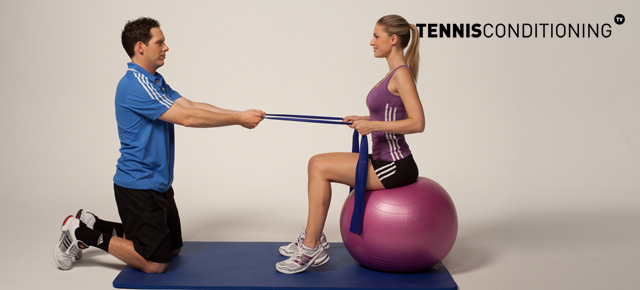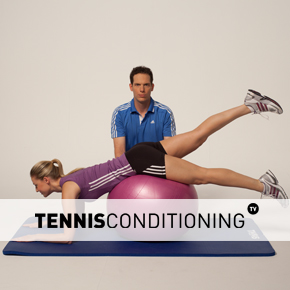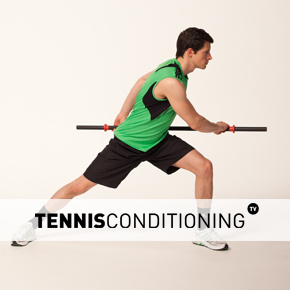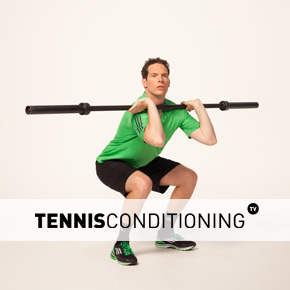The Assisted Seated Physio Ball Hip Flexion to Extension is a low back exercise for beginners to improve hip extensor strength, trunk extensor strength, core stabilization, balance and proprioceptive capabilities.
During the Assisted Seated Physio Ball Hip Flexion to Extension the focus is on strengthening the low back. It is part of the core and hence important for energy transfer when hitting the ball.
The posterior aspect of the core is very important in energy transfer and injury prevention. Hence you should be strengthening it regularly to ensure proper joint integrity and enhanced energy transfer.
Find out more about Why Core Training for Tennis Players is Important.
Assisted Seated Physio Ball Hip Flexion to Extension Description

Coach kneels on the ground and assists movement via elastic band.
- Sit upright on top of the physio ball; hips and legs flexed at 90˚; knees are outside shoulders
- Hold elastic band in both hands; arms remain straight during movement
- Coach pulls elastic band towards himself/herself; athlete simultaneously flexes hips and maintains neutral spine position during movement; hold 1 second; extend chest and retract the scapular throughout the movement; keep looking forward during movements
- Athlete extends hips thereby returning to seated position; coach provides resistance
Physio Ball Hip Flexion to Extension Progression
If you use additional weights or increase the strength of the resistance bands…make sure you use appropriate resistance so you can control the action throughout the entire range of motion. Otherwise you may defeat the purpose of the exercise.
Very often, people use too much resistance and they become sloppy. Especially when it comes to maintaining dynamic stability.
No eccentric phase, the tension is basically just released. Make the most out of your training time and work your way up to appropriate weights or level of resistance.
It may also be a good idea to work on other aspects of the core equally as hard as your lower back to avoid strength imbalances.
Apart from looking weird strength imbalances can also lead to injuries.
Also, don’t just progress with adding more weight. Instead don’t look towards the ground while flexing and extending the hip. Keep your head up and look forward. All while maintaining perfect form.
If that’s still too easy then keep your head up and track and object/person while flexing and extending the hip.
Here are the progression levels:
- Beginner: look down
- Advanced: look forward
- Professional: look forward & track an object/person
Related Strength for Performance Exercises
- Assisted Prone Physio Ball Unilateral Leg Extension
- Bilateral Lunge with Bar Rotations
- Front Squat and Press
Training Zone
We provide you with some more workouts and training tips you may be interested in to optimize your training.
Also, make sure that you warm up properly before and stretch out after your training session.




